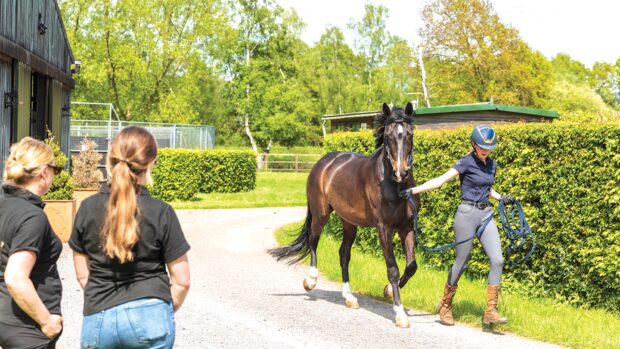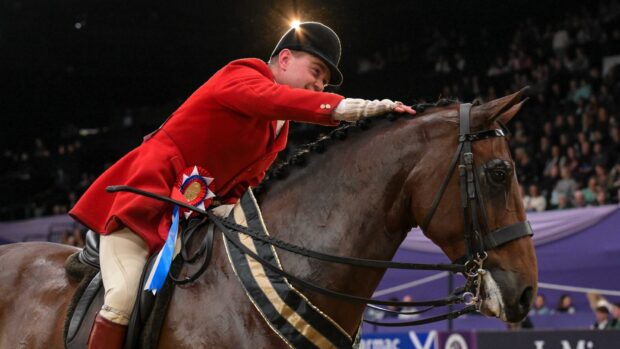A ladies’ horse for the show ring has a niche set of requirements, so if you’re looking to buy a side-saddle horse for this season or for some time in the future, then our guide is a must-read.
What is riding side-saddle?
Side-saddle is a style of riding that requires the rider to sit with both legs to one side of the saddle, rather than astride. Traditionally, side-saddle riding was undertaken by women out hunting, hence the word ladies’ being used when referring to side-saddle showing classes. Sitting sideways allowed a woman to ride a horse while also wearing a long dress.
Compared to riding astride, a side-saddle rider sits further back and on more top of the horse with both legs positioned to one side. Many riders carry a cane to use as a guide, support and to give signals to the horse on the offside, and have a longer length of rein.
Many showing classes permit side-saddle riders and there are also a host of sections and shows specifically for enthusiasts, such as the National Side-Saddle Association championships. On the showing circuit, the most prestigious classes to win are the ladies’ show hunter final at the Royal International (RIHS) and the ladies’ show horse of the year at the Horse of the Year Show (HOYS).
Many riders choose to ride sideways and there are many opportunities to give it a go aside from in the show ring. Hunting and dressage are disciplines where you may spot side-saddle riders.
Will my current horse do side-saddle?
Katie Jerram-Hunnable has ridden many top side-saddle horses during her career. She was supreme at HOYS in 2010 with the ladies’ champion Dunbeacon.
Katie advises that if you have a younger horse that has never carried a side-saddle before, then it is not a given that the horse will take to it.
“While you can often predict if a horse is going to carry a side-saddle due to their stamp and how they are put together, sometimes they just don’t like the feel of it,” Katie says. “In this instance I would not push it; it’s a big heavy saddle and it can provide a feeling that not every horse will cope with.”
What qualities should I look for in a side-saddle horse?
“A good ladies’ horse should not be so big that it’s possibly intimidating,” Katie continues. “For me, an ideal stamp would be somewhere between a large riding horse and a lightweight hunter, and in years gone by, the top ladies’ rides were lovely thoroughbred horses.”
Conformation, like in any type of show horse, is key, as Katie explains: “You want a nice shoulder, a good length of rein and somewhere for the saddle to sit comfortably on the back. For the ladies’ job, I would avoid a horse that is too tall – it will be difficult for the judge to get on – or something with flat withers. I would also avoid a horse with choppy striding, an upside down neck or an excessively straight shoulder. If the horse had plenty of length through the ribs that would be preferable to a horse that was shorter and more butty in its body.
“Temperament wise, you want a horse that is trainable, and also not cold backed in the slightest,” Katie adds. “Side-saddle horses have to cope with a lot; you only have one leg, using a stick as the other, so they do need to be relatively easy going, though they can learn and improve with consistent training. I like a horse with a good mouth for this job; when I’m ride judging I like to be able to take a contact. We don’t want something that holds itself too high or won’t take the rein forward, we are looking for an even and soft feel in the contact.”
How much should I expect to pay?
Horses vary in price depending on many factors such as competition record, breeding, age, temperament and experience, as well as the situation of the seller. As a ladies’ horse will likely have a sound temperament and usually takes a side-saddle as a secondary job, they can fetch higher prices.
“I would expect to pay between £15,000 and £30,000 for a good ladies’ horse with a nice temperament and quality conformation,” says Katie. “That is quite a large window, but an open horse or something that is at least up and running in a side-saddle would be in demand.”
Where should I look?
Side-saddle horses will be advertised at various times in the season on online platforms, via private sellers and professional horse dealers. Horses are sometimes sold via word of mouth.
Katie has introduced many horses to a side-saddle herself, though she says this is not something to introduce during a viewing: “If someone came to view a horse that had never taken a side-saddle before and asked if it could be ridden in one on the day, I would say no, even if they thought it to be the ideal stamp for the job. This would be your responsibility once you got the horse home and had gotten used to him astride. Rome wasn’t built in a day, so don’t rush this process.”
I’ve agreed to buy a horse, now what?
When you have agreed on a sale, it is time to organise a pre-purchase vetting, something that is strongly recommended.
The vet will assess the horse with the specific job you want it for in mind, so it’s important to let the vet know prior to the vetting that your main goal is to ride side-saddle. If you tell the vet that you want the horse for the show ring, they should hopefully inform you of any blemishes or conformational faults which could impact its future career, even if they don’t impact its soundness or performance.
“I would never sell a horse without a vetting being done, and I would never buy a horse without a vetting certificate, either,” says Katie. “A five-stage would be preferable for an open show horse.”
For more information, you can read H&H’s ultimate guide to buying a horse.
- To stay up to date with all the breaking news from major shows throughout the season, subscribe to the Horse & Hound website
You may also be interested in:

Effortless elegance (or so it seems): refine your side-saddle skills to glide to the top of the ladies’ show horse line-up

Side by side: Three generations of side saddle riders compete at championship show
Keeping it in the family...

Irish rider breaks world side saddle high jump record
Susan Oakes and her grey stallion SIEC Atlas cleared 6'8" (2.03m), beating an unofficial record set in Australia over 100

Side-saddle rider and multi-talented gelding cut elegant picture at Winter Dressage Championships

Subscribe to Horse & Hound magazine today – and enjoy unlimited website access all year round




